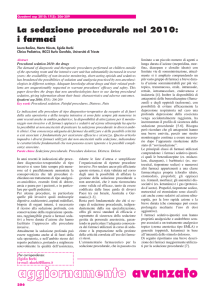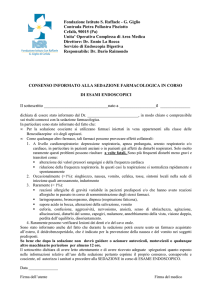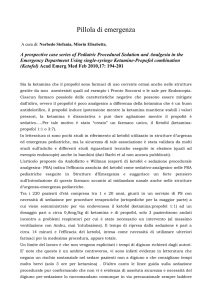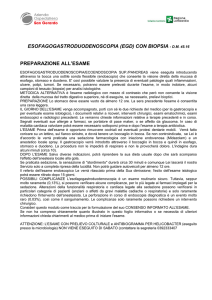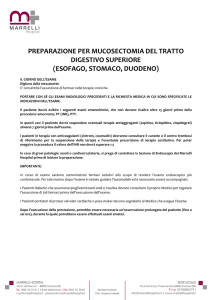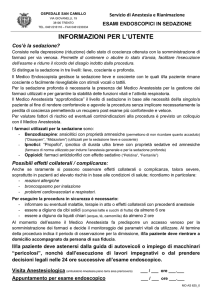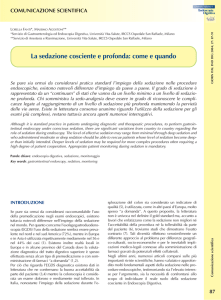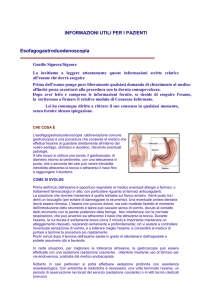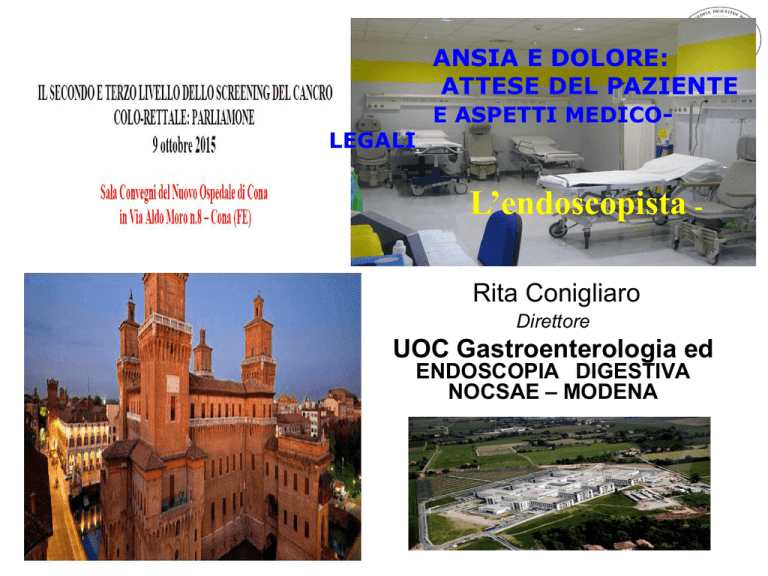
ANSIA E DOLORE:
ATTESE DEL PAZIENTE
LEGALI
E ASPETTI MEDICO-
L’endoscopista Rita Conigliaro
Direttore
UOC Gastroenterologia
ed
Fate clic per aggiungere
testo
ENDOSCOPIA DIGESTIVA
NOCSAE – MODENA
RIDUZIONE DELL'ANSIA , DEL “DISAGIO
“ = SEDAZIONE ? ANALGESIA ?
Il “disagio durante la colonscopia “ è provocato da :
ansia dell’esame e dell’esito dello
stesso
invasività della procedura operativa
dolore da distensione addominale
stiramento dei mesi
fenomeni riflessi agli stimoli
nocicettivi
Sedation in GI Endoscopy
AIMS
The aims of sedation for endoscopic procedures
are:
Abolition/reduction of patient discomfort
More safety for the patient due to improved
analgesic protection
Easier and more accurate performance of
endoscopic procedure
Stage of sedation
JCAHO TERMINOLOGY
(Joint Commission on Accreditation of Healthcare Organisations 2001)
MINIMAL SEDATION (anxiolysis): reaction to verbal commands
MODERATE SEDATION/ANALGESIA : sonnolence , reaction louder
commands, additional tactile stimulation, if necessary
DEEP SEDATION (può richiedere intervento sulle vie aeree) hard to
wake, purpseful response after repeated or painful stimulation
GENERAL ANESTHESIA
AA Task Force 2002 :96 : 1004-1017
G GL Endoscopy 2009 ; 41 :787-815
“
SEDAZIONE IN ENDOSCOPIA
Revisione febbraio 2006
SEDAZIONE IN ENDOSCOPIA
Sedation in GI Endoscopy
German Guidelines (DGVS) 2008
Reccomendation : Sedation should be offered to
every patient before endoscopy
The advantages and disadvantages should be
discussed in detail every patient has the right to an
endoscopic examination pain-less and stress –free
Recommendation Grade A, evidence 5 ,
consensus (75-98%)
Endoscopy 2009 ; 41 :787-815
The Athens Consensus Statement on
Sedation in Digestive Endoscopy
An international position statement produced by the World
Organization of Digestive Endoscopy (OMED) the Hellenic
Society of Gastroenterology (HSG) and the European Society of
Gastrointestinal Endoscopy (ESGE)
The meeting was endorsed by the American Society for
Gastrointestinal Endoscopy (ASGE).
Appendix. OMED Sedation Panel Participants
Helen M Arnaoutoglou (Greece); Anthony T.R. Axon* (United Kingdom); Andrew Axon (United Kingdom); Georgios
Bamias (Greece); David J. Bjorkman* (USA); Lawrence B. Cohen* (USA); Rita Conigliaro (Italy) ; Edward Despott
(United Kingdom); Jacques Devière* (Belgium); Mário Dinis-Ribeiro (Portugal); Lorella Fanti (Italy); Argyro Fassoulaki
(Greece); Nikolaus Hofmann (Austria); John A. Karagiannis (Greece); Dimitrios Karamanolis (Greece); George Kitis
(Greece); Spiros D Ladas* (Greece); Walter Maurer (USA); Spiros Michopoulos (Greece); John Morse (Canada); Ibrahim
Mostafa (Egypt); Anthony O'Connor (Ireland); Konstantina Paraskeva Greece); Gregorios A Paspatis* (Greece); Thierry
Ponchon (France); Yoshiharu Satake (Japan); Florian Schreiber (Austria); Konstantinos Triantafyllou (Greece); Phillip Van
der Linden* (Belgium); John J Vargo* (USA); Nikos Viazis (Greece); Ioannis Vlachogiannakos (Greece); Till Wehrmann
(Germany).
The Athens Consensus Statement on
Sedation in Digestive Endoscopy
Statement 4. Sedation is the standard of care
during diagnostic and therapeutic endoscopic
procedures in many areas of the world.
Statement 6 Sedation may improve the quality of an
endoscopic examination.
Choen LB. Aliment Pharmacol Ther. 2010
DOCUMENTAZIONE REGIONALE
*
BUFFET
MENU’ FISSO
A LA CARTE
Fate clic per aggiungere testo
CUCINA ALTERNATIVA
DIGIUNO
Wong RC Gastrointest Endosc. 2001 Jul;54(1):122-6.
COME OTTENERE LA MIGLIORE PERFORMANCE
NELLA SEDAZIONE?
BENZODIAZEPINE
Diazepam
Midazolam
HYPNOTIC
Propofol
OPIOID
Fentanyl
Remifentanyl
Petidina
Sevorane
Isoforane
Protossido d’azoto
GAS
AGOPUNCTURE
HYPNOSIS
SEDAZIONE IN ENDOSCOPIA
....la sedazione è un continuum
Respiro spontaneo
Riflessi protettivi mantenuti
Risposta appropriata
Paziente
sveglio
⇒
⇐
Sedazione
analgesia
minima o
moderata
⇔
⇒
⇐
Respiro assistito/controllato
Riflessi protettivi assenti
Risposta inappropriata
Sedazione
analgesia
profonda
⇒
⇐
Anestesia
generale
ARRESTO CARDIOPOLMONARE
Sedation in Endoscopy
RICHIEDERE IL CONSENSO
INFORMATO
ALLA SEDAZIONE /
ANALGESIA
CONTESTUALMENTE
ALLA RICHIESTA DI
CONSENSO ALLA
PROCEDURA ENDOSCOPICA
Previene problemi medicolegali
DGVS GL Endoscopy 2009 ; 41 :787-815
SEDATION IN ENDOSCOPY
Raccolta
dell’anamnesi
infermieristica e del
Consenso Informato
anche alla sedazione
dal Medico
Monitoraggio chi?
IL RESPONSABILE
DELLA
SOMMINISTRAZIONE
DEI FARMACI PER LA
SEDO-ANALGESIA E
DEL MONITORAGGIO
E’ IL MEDICO
ENDOSCOPISTA!!!
Un operatore diverso
dall’endoscopista che
abbia
ricevuto
un
addestramento
adeguato
per
la
sedazione
in
endoscopia e che sia
presente durante tutta
la procedura
Sedation in Endoscopy
The type and intensity of sedation and the drug used should be
selected according to the type of intervention , the patient’s ASA
grade and the individual risk profile
Recommendation A, evidence 5,
strong
consensus
DGVS GL Endoscopy 2009 ; 41 :787-815
Quando è necessaria
la presenza
dell’anestesista?
procedure diagnostiche,
terapeutiche e/o operative
prolungate che richiedano
sedazione profonda
intolleranza prevista ai sedativi
standard
alto rischio di complicanze in
relazione a comorbidità severe
(ASA 3-4)
alto rischio di ostruzione delle vie
aeree legato a varianti anatomiche
Pazienti non collaboranti
(bambini, psichiatrici, demenza,
alcolizzati, tossicodipendenti)
Pazienti a cui non siamo in
grado di assicurare
la pervietà delle vie aeree
durante la procedura o
l’immediato accesso alle vie
aeree o con prevedibile
instabilità Emodinamica
(es. emergenze emorragiche,
CE..)
Monitoraggio
Sedation in Endoscopy
Affidare l'esecuzione e
la vigilanza sulla sicurezza
della sedazione/analgesia a
personale diverso dall'operatore,
adeguatamente formato e
addestrato. (tipo C)
DGVS GL Endoscopy 2009 ; 41 :787-815
Monitoraggio
QUANDO ?
pre-procedura
dopo la somministrazione dei farmaci per
la sedo-analgesia
ad intervalli prestabiliti, durante la
procedura
durante la fase di recupero
prima della dimissione
Dimissibilità
Predefinire criteri oggettivi di dimissibilità che tengano conto di una
persistente stabilità dei parametri vitali, dei livelli di vigilanza, orientamento
temporo-spaziale e coordinamento psicomotorio
Avvertire il paziente della possibile persistenza per diverse ore di effetti
residui dei farmaci utilizzati per la sedazione/analgesia sulle funzioni
intellettive
Fornirgli informazioni scritte sulle precauzioni da adottare, e un riferimento
telefonico a cui rivolgersi in caso di necessità
DOSAGGI E MODALITA’
DI SOMMINISTRAZIONE
Procedura ideale
Paziente ideale
Farmaco ideale
MODALITÀ DI SOMMINISTRAZIONE
DEFINIZIONI
Standard sedation: BDZ +- Oppioidi: endoscopista
NAAP : Non-anesthesiologist administered propofol
NAPS : Nurse-Administered Propofol Sedation :
MAC : Monitored anesthesia care
PSD : Propofol single dose
BPS : Balanced Propofol Sedation : BDZ e/o oppioide + Propofol
SEDAZIONE IN ENDOSCOPIA
Il medico che usa la sedazione lo fa dopo adeguato training e seguendo protocolli
ben standardizzati, deve saperne gestire completamente gli effetti
Non ci si nasconda dietro la rassicurante espressione “sedazione”: la differenza tra
sedazione ed anestesia è solo una questione di dosaggi e di risposta del paziente. L’
approccio è lo stesso.
La legge potrebbe valutare con severità l’imprudenza di un non-anestesista che si
avventurasse ad impartire un qualsiasi regime di sedazione seguito da una ingestibilità
delle vie aeree.
Qualsiasi scelta si faccia ognuno deve porsi il problema di saper gestire gli effetti
avversi di questi farmaci e soprattutto saper gestire l’ emodinamica e le vie aeree.
ENDOSCOPIST-DIRECTED ADMINISTRATION OF
PROPOFOL: A WORLDWIDE SAFETY EXPERIENCE
METHODS:
We reviewed all published work using EDP. We contacted all endoscopists performing EDP for
endoscopy that we were aware of to obtain their safety experience. These complications were
available in all patients: endotracheal intubations, permanent neurologic injuries, and death.
RESULTS:
A total of 646,080 (223,656 published and 422,424 unpublished) EDP cases were
identified. Endotracheal intubations, permanent neurologic injuries, and deaths were 11, 0, and 4,
respectively. Deaths occurred in 2 patients with pancreatic cancer, a severely handicapped patient
with mental retardation, and a patient with severe cardiomyopathy. The overall number of cases
requiring mask ventilation was 489 (0.1%) of 569,220 cases with data available. For sites specifying
mask ventilation risk by procedure type, 185 (0.1%) of 185,245 patients and 20 (0.01%) of 142,863
patients required mask ventilation during their esophagogastroduodenoscopy or colonoscopy,
respectively (P < .001). The estimated cost per life-year saved to substitute
anesthesia specialists in these cases, assuming they would have
prevented all deaths, was $5.3 million.
Rex DK. Gastroenterology 2009
The Athens Consensus Statement on
Sedation in Digestive Endoscopy
Statement 10 . ASA I, II and many III
patients can be safely sedated for endoscopy
by a trained endoscopist/nurse team. …....................
…...Similar findings were observed with
propofol-mediated sedation, although the odds
ratio differed slightly.
Choen LB. Aliment Pharmacol Ther. 2010
QUALI FARMACI?
BZD (Midazolam e
Diazepam)(Flumazenil)
OPPIACEI (Meperidina e
Fentanyl Remifentanyl)(Naloxone)
PROPOFOL
SINGOLARMENTE O IN ASSOCIAZIONE
SEDAZIONE IN ENDOSCOPIA
BASIC LIFE SUPPORT
Airway
Breathing
Circulation
ADVANCED CARDIAC LIFE SUPPORT
Intubazione
Defibrillazione
Farmaci
SEDAZIONE IN ENDOSCOPIA
NAPS
ESISTONO LIMITAZIONI LEGISLATIVE
RIGUARDO L’USO DEL PROPOFOL DA
PARTE DEI NON ANESTESISTI?
SEDAZIONE IN ENDOSCOPIA
NAPS
Propofol IBI: Generalmente il farmaco e'disponibile soltanto in ospedale. La
somministrazione del farmaco è soggetta a certe regole e deve avvenire esclusivamente
sotto controllo di personale medico qualificato. Il dosaggio più adatto viene stabilito
dall'anestesista.
Propofol Kabi: 10 mg/ml deve essere somministrato solamente negli ospedali o da medici
specializzati in anestesia nelle unità di terapia diurna adeguatamente equipaggiate o nella
cura dei pazienti in terapia intensiva. Devono essere costantemente monitorate le
funzioni circolatorie e respiratorie (es.ECG, ossimetria da polso) e devono essere
prontamente disponibili in ogni momento i mezzi per il mantenimento della pervietà delle
vie aeree del paziente, per la ventilazione artificiale e altri mezzi di rianimazione.
Propofol Braun: Deve essere somministrato solo in ospedali o in centri terapeutici
giornalieri adeguatamente attrezzati da medici specialisti in anestesia o nella cura di
pazienti in terapia intensiva
Normativa AIFA
“Il fatto che sulle preparazioni commerciali venga specificato che il
propofol va usato solo dagli anestesisti va inteso come
notazione di carattere precauzionale adottata dal titolare
dell’autorizzazione in commercio del farmaco ma NON HA
VALENZA RESTRITTIVA non potendo stabilire un limite rispetto
a quanto stabilito da AIFA e pubblicato in gazzetta ufficiale”.
Il propofol in Gazzetta Ufficiale appartiene alla classe d2 e cioè
farmaco utilizzabile solo in ambiente ospedaliero o
equipollente senza alcuna specifica su chi deve
somministrarlo: tale specifica riguarda solo i farmaci di
categoria d3 a cui il propofol non appartiene.
SEDAZIONE IN ENDOSCOPIA
Non Anaesthesiologyst Administration
Propofol NAAP
COSA NE PENSANO GLI
ANESTESISTI?
CONTROGUIDELINES DI 21 PAESI
EUROPEI ( compresa l’Italia)
Non-anaesthesiologists should not be
allowed to administer propofol for
procedural sedation: a Consensus
Statement of 21 European National
Societies of Anaesthesia.
.
Perel A. Eur J Anaesthesiol 2011 Aug;28(8):580-4
Italian Postion Statement
Non-anesthesiologist administration of
propofol during GI endoscopy
Endorsement della
FISMAD?? e della
SIAARTI?????
Conigliaro R , Fanti L, Manno M, Brosolo P : Working progress
SEDAZIONE IN ENDOSCOPIA
Non Anaesthesiologyst Administration
Propofol NAAP
STIAMO CERCANDO, IN MODO
AUTOLESIONISTICO, DI ACCOLLARCI
NUOVE RESPONSABILITA’ ?
“Io
non Creto “
Digestive Endoscopic Unit NOCSE
Baggiovara- Modena (Italy)
Director Dr.ssa R.Conigliaro

